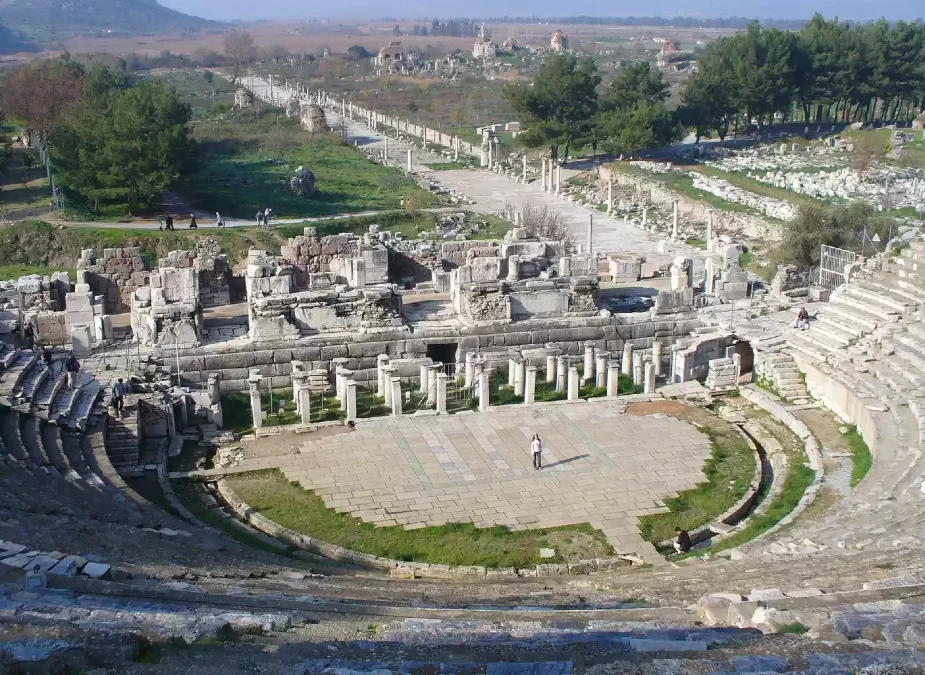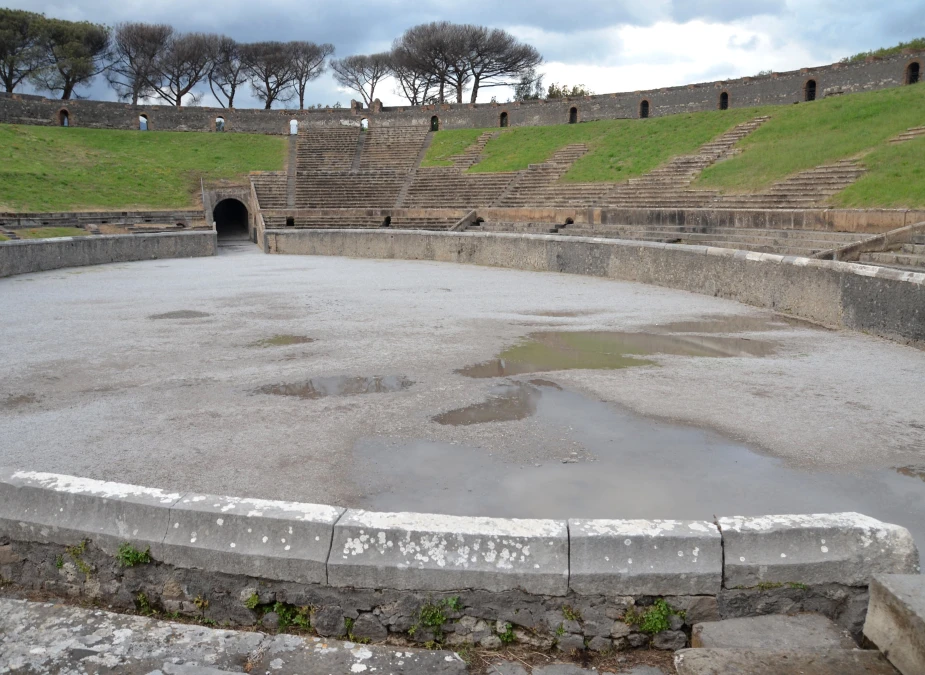The Colosseum Amphitheatre, an architectural marvel and iconic emblem of ancient Rome, exemplifies Roman inventiveness and grandeur. The Colosseum’s elliptical form, derived from the Greek words amphi, offered viewers an immersive, all-around viewing experience.
Inspired by older Greek and Roman theatres, the Colosseum outperformed them with its huge size and inventive features, such as the hypogeum’s intricate tunnels. It hosted gladiatorial combats, wild animal hunts, and reenactments. It served as an instrument for political authority, social control, religious expression, and entertainment.
The Significance of the Name
The Colosseum Amphitheatre is named the Flavian Amphitheatre because it was constructed in the Flavian dynasty. The Greek words amphi, which means on both sides or around, and theatron, which means a place for viewing, are the roots of the phrase amphitheater. This phrase perfectly captures the Colosseum’s architecture, which had a feature that let spectators see events from every angle.
Unlike traditional theatres, which usually featured semicircular designs, the Colosseum’s elliptical form gave an immersive and open viewing experience, earning it the amphitheater title. The Colosseum’s form and purpose made it evident that it was an amphitheater.
In contrast to other Roman structures that functioned as basilicas, temples, or forums, the Colosseum was built with public spectacles in mind. Its name, which highlights its function as a place for entertainment that could hold thousands of people in an encircling arrangement, symbolizes this goal.
Inspirations from Other Amphitheatres
The Colosseum was not built in a vacuum. Roman builders took inspiration from existing amphitheaters throughout their enormous empire. Here’s an overview of some significant influences:
Greek theatres

Although the Greeks greatly affected the construction of the amphitheater, the Romans invented the concept. Greek theatres, distinguished by their semicircular shapes, offered a fundamental concept that the Romans developed. The Colosseum, with its tiered seating arrangement and emphasis on acoustics and sightlines, used Greek concepts to provide spectators with unobstructed views and audible commentary.
Pompeii Amphitheater (present-day Pozzuoli, Italy)

Smaller amphitheaters like the Pompeii Amphitheater were models for the eventual big Colosseum before it was built. The Colosseum used many aspects of these forerunners, including its elliptical form, which provided a wider and more diversified viewing area. Furthermore, the elaborate system of tunnels and chambers known as the Colosseum’s hypogeum was modeled after older Roman amphitheaters but was built on a far larger scale.
The Samnite Amphitheater
Built in 70 BC in Rome, this ancient amphitheater served as a foundation for the design of the Colosseum. It used a similar oval-shaped arrangement with tiered seating, which led to a larger, more ornate building.
Step into history by purchasing tickets to the famed Colosseum Amphitheatre, where you can see the majesty and magnificence of historic spectacles!
However, the Romans were not copycats. They used existing concepts and pushed the frontiers of engineering and design. The Colosseum’s vastness, the use of novel building materials such as concrete, and the intricate system of lifts and ramps for performers and animals were all Roman innovations.
Types of Events Held in the Amphitheatre
The Colosseum featured a variety of spectacles, usually classified into three primary types:
Munera
These were gladiatorial fights, the most famous and violent of the games.
Gladiators, who were frequently enslaved people, convicted criminals, or prisoners of war, battled each other or wild animals for the enjoyment of the audience. Gladiators were respected for their skill and bravery; some even became superstars.
However, the audience determines their destiny, which might lead to death or pity.
Venatio
Animal hunts, also known as venatio, were a popular source of amusement.
Exotic creatures from around the Roman Empire, such as lions, tigers, elephants, bears, and rhinoceroses, were brought to the Colosseum to compete or be hunted by professional performers.
Silvae
Silvae are staged battles that reflect renowned historical events or legendary themes.
These extravagant plays featured hundreds of actors, intricate scenery, and even flooded arena floors to depict naval conflicts.
Silvae acted as historical instruction and propaganda, reminding people of Rome’s authority and military strength.
Inspiration for the Games
The gory and dramatic aspect of the Colosseum games did not emerge out of thin air. Roman entertainment took inspiration from a variety of sources:
Etruscan Influence: The Etruscans, an ancient culture in Italy before the Romans, staged gladiatorial games as part of their burial ceremonies. The Romans took up this technique and incorporated it into their games.
Greek Influence: Greek athletic events and theatrical performances significantly impacted Roman entertainment. In their amphitheatres, the Romans produced several Greek dramatic genres, including comedies and tragedies.
Gladiatorial Combats: The Samnites, a southern Italian population who regularly battled with the Romans, included gladiator fights in their sacred festivals. After defeating the Samnites, the Romans adapted this tradition into their games.
Carthaginian Influence: The Carthaginians, a great North African culture, are said to have organised venatio, or animal hunts, for public amusement. The Romans most likely adopted this strategy following their triumphs in the Punic Wars.
Uncover Colosseum!
Book curated experiences handpicked by our world-trusted partners.
Blending Influences
These are only a few primary impacts on the games staged at the Amphitheatre. The Romans used these many traditions to create distinct entertainment that mirrored their cultural beliefs and political reality.
A Tool of Power
The games enabled Roman emperors to establish their authority and get the people’s favour.
Their funding and sponsorship of magnificent games exhibited the emperor’s riches and generosity.
Victories in staged wars might be interpreted as symbolic victories against foes, enhancing the emperor’s image.
Social Control and Public Order
The games also helped to maintain social order.
By providing an accessible and attractive form of entertainment, the Roman aristocracy diverted public attention away from political matters and possible rebellion.
The brutal character of the games served as an alarm to anyone who went to resist Roman rule.
Religious Significance
Some sports played in the Colosseum were also associated with religious ideas.
Animal hunts were occasionally viewed as sacrifices to the gods, and staged battles symbolized legendary confrontations.
How Did the Entertainment Work?
The Colosseum did host a variety of types of entertainment, some of which may have had tragic aspects. Here is how the Colosseum’s entertainment system worked:
Stage Setup and Special Effects
Arena: The arena’s hardwood floor might be coated in sand to absorb blood. The hypogeum, a complex network of tunnels and chambers, lay under the floor.
Trapdoors and elevators: These were employed to provide spectacular entrances for gladiators and animals, allowing them to arrive unexpectedly on the arena floor.
Scenery and Props: Large moveable sets, props, and painted backdrops were employed to create several settings and add to the spectacle.
The Hypogeum
Underground Complex: The hypogeum held gladiators, animals, and stage equipment. It was a hive of activity as slaves, stagehands, and actors prepared for the shows.
Elevators and pulleys: These systems were employed to transport animals and scenery to the arena floor, resulting in unexpected and spectacular results.
Audience Experience
Seating layout: The amphitheatre featured a hierarchical seating layout, with the wealthy occupying the finest seats and the common public sitting further back.
Sound and Acoustics: The Colosseum’s architecture provided for superb acoustics, so the sounds of the events could be heard well throughout the stadium.
Public Participation: The crowd actively participated, cheering for their favorite gladiators and responding to the spectacular displays.
Organisers and Sponsorship
Emperors and Politicians: Many events were sponsored by emperors or politicians looking to acquire popularity with the populace.
Ludi (Games): These were part of bigger festivals and public holidays, and they frequently lasted several days.
Why is the Colosseum Most Celebrated Amphitheatre?
The Colosseum is the most famous amphitheatre for a variety of reasons.
Engineering Marvel: It was built between 70 and 80 AD and is the biggest standing amphitheatre to this day. Its intricate engineering, which included tiered seats, a complicated drainage system, and a retractable ceiling (velarium), set the standard at the time.
Historical significance: For decades, it functioned as a hub for Roman entertainment, staging gladiatorial combats, animal hunts, public executions, and theatre productions. This provides an insight into Roman culture and social life.
Symbol of strength: Built by the Flavian emperors, it represents the Roman Empire’s strength and riches.
Architectural Inspiration: The design of the Colosseum impacted amphitheatre building throughout the Roman Empire, and it continues to inspire architects and engineers today.
Enduring Legacy: Despite earthquakes and devastation, the Colosseum is still a potent emblem of old Rome. Its ongoing presence connects us with the past and continues to attract people from all around the world.
FAQs
1. What is the Flavian Amphitheatre?
Known by most as the Colosseum, the Flavian Amphitheatre was constructed as a public amphitheatre by the Romans.
2. Why is the Flavian Amphitheatre also called the Colosseum?
The enormous statue of Nero that formerly stood close here gave rise to the term Colosseum.
3. What types of events were held at the Flavian Amphitheatre?
Gladiatorial matches, public executions, simulated sea wars, and animal hunts.
4. Is the Colosseum ticket the same for the Flavian Amphitheatre?
The Colosseum and Flavian Amphitheatre are simply two names for the same famous building. Thus, a ticket for the Flavian Amphitheatre is identical to one for the Colosseum.
5. Were there other amphitheatres similar to the Flavian Amphitheatre?
Yes, but none had the same majesty and scale. The Capua Amphitheatre and the Verona Arena are two examples.
6. What makes the Flavian Amphitheatre unique compared to Greek theatres?
It is distinct from the semicircular Greek theatres by its elliptical form and ability to host large-scale shows.
Featured Image : Britannica.com



